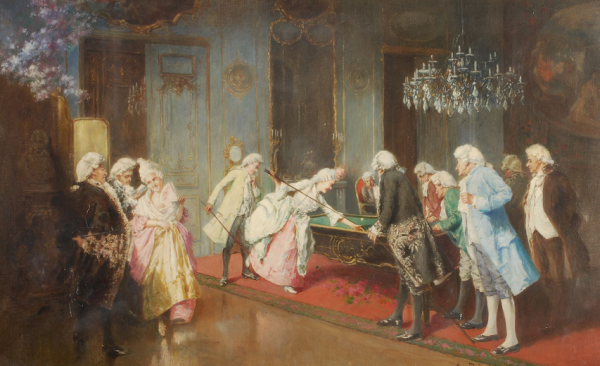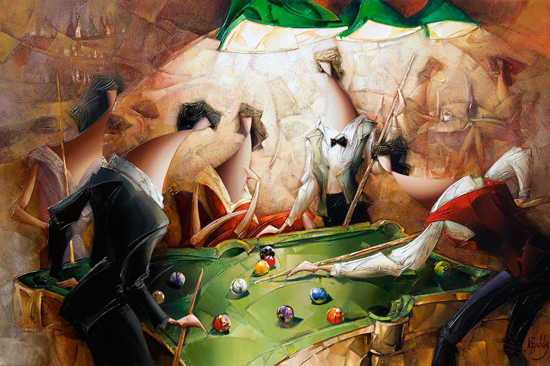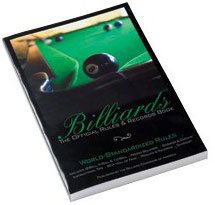
The history of billiards is long and very rich. The game has been played by kings and commoners, presidents and mental patients, ladies, gentlemen and hustlers alike. It evolved from a lawn game similar to the croquet played sometime during the 15th century in Northern Europe and probably in France. Game-play was moved indoors to a wooden table with green cloth to simulate grass, and a simple border was placed around the edges. The balls were shoved, rather than struck, with wooden sticks called “maces.” The term “billiards” is derived from French, either from the word “billart,” one of the wooden sticks, or “bille,” a ball.
The cue stick was developed in the 1600s. When the ball lay near a rail, the mace was very inconvenient to use because of its large head. In such a case, the players would turn the mace around and use its handle to strike the ball. The handle was called a “queue” meaning “tail.” We went on to calling the sticks “cues”.
Tables originally had felt vertical walls for rails and their only canton was to keep the balls from falling off. They resembled riverbanks and even used to be called “banks.” Players discovered that balls could bounce off the rails and began deliberately aiming at them. Thus a “bank shot” was born.
Billiard equipment improved rapidly in England after 1800, largely because of the industrial revolution. Chalk was used to increase friction between the ball and the cue stick even before cues had tips. The leather cue tip, with which a player can apply sidespin to the ball, was perfected by 1823. English visitors showed Americans how to use spin, which explains why it is called “English” in the United States but nowhere else. (The British call it “side”). The Two-piece cue arrived in 1829. Slate became popular as a material for table beds around 1835. Goodyear discovered vulcanization of rubber in 1839 and by 1845 it was used to make billiard cushions. By 1850, the billiard table had essentially evolved into its current form.
The dominant billiard game in Britain from about 1770 until the 1920s was English Billiards or Billiards was and still is played with three balls and six pockets on a large rectangular table.
Another game played on a table is Snooker, a complex and colorful game combining offensive and defensive aspects and played on the same equipment as English Billiards but with 22 balls instead of Three. The British appetite for Snooker is approached only by the American passion for baseball; it is possible to see a Snooker competition every day in Britain.
Billiard in The United States:
How billiards came to America has not been positively established. There are tales that it was brought to St. Augustine by the Spaniards in the 1580s but researchers failed to reveal any trace of the game there. A number of American Cabinetmakers in the 1700s turned out exquisite billiard tables, although in small quantities. The game spread throughout the colonies. Even George Washington was reported to have won a match in 1748. By 1830, despite primitive equipment, public rooms devoted entirely to billiards appeared. The most famous of them was Bassford’s, a New work Room that catered to stockbrokers. Here a number of American versions of billiards were developed.
Eight-Ball was invented shortly after 1900; Straight Pool followed in 1910. Nine-Ball seems to have developed around 1920. The most commonly played pool game is Eight-Ball, played against other players. The goal is to get all your balls in the pockets before your opponent does.
While billiards has developed through history it’s waged a constant battle of respectability. Producing an environment in which men, women, experts, and novices can come together meeting socially for one of the many friendly games played on a Billiard Table.
Be sure to come into our showroom and pick up your very own copy of Billiards The Official Rule & Record Book. The Billiard Congress of America works with the World Pool and Billiard association to set rule standards for all related games. In addition, this book holds biographies of great BCA Hall of Fame members from the over 50-year history of the BCA. This book was the source of information for this blog. Thank you.


